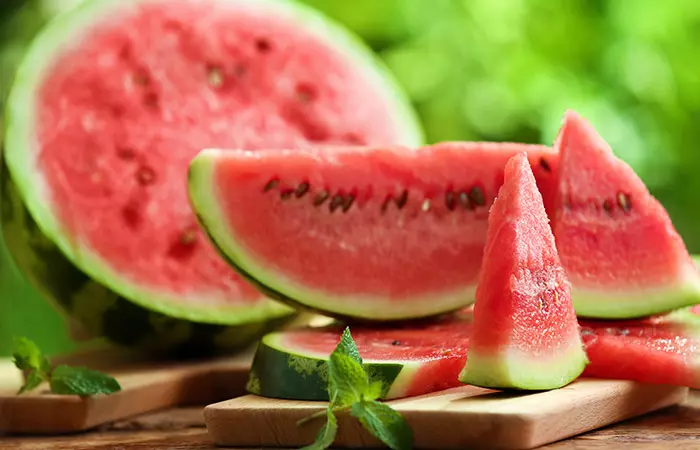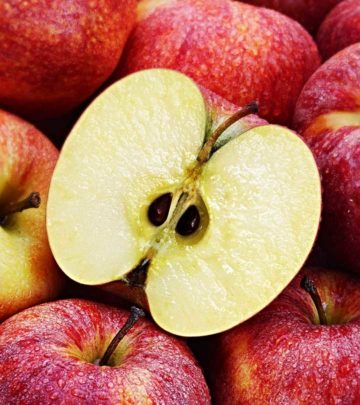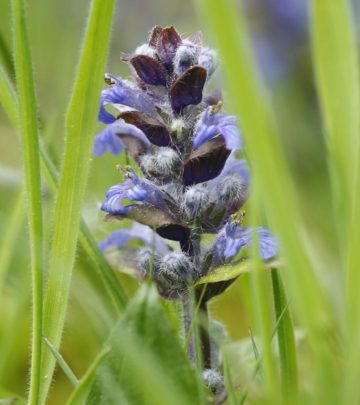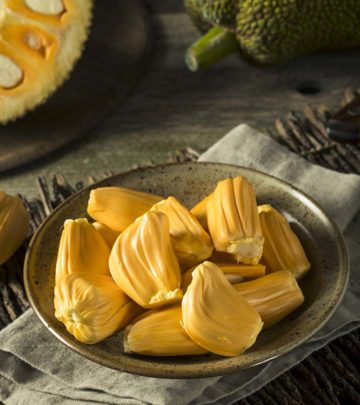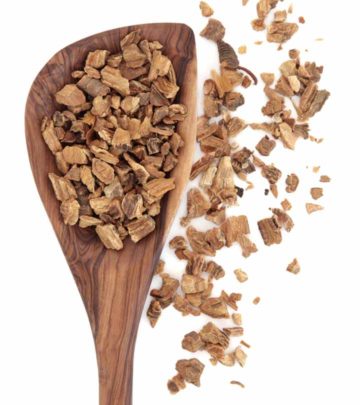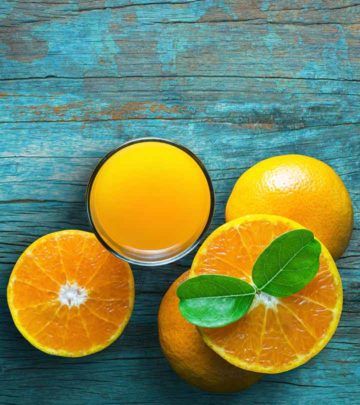Nitrates: The Truth About Them + Top 9 Foods

Image: shutterstock
Nitrates are compounds commonly found in veggie-rich diets, including leafy greens. They are also added to cured meats like bacon and hot dogs as color preservatives to retard the growth of microorganisms. Though nitrates may have some health benefits, there is another side to them that is not quite as pleasing.
In This Article
What Are Nitrates?
To understand nitrates, we must also know about nitrites. Let’s delve into a bit of chemistry. Nitrate contains 1 nitrogen atom bonded to 3 oxygen atoms, whereas, nitrite contains 1 nitrogen atom bonded to 2 oxygen atoms.
Nitrates, by themselves, are inert. It is only when they come in contact with the bacteria in the mouth and other bodily enzymes do they get converted into nitrites.
Nitrites, in turn, can get converted into nitric oxide or nitrosamines. It is at this stage we either have good news or bad news. Nitric oxide has been found to reduce arterial stiffness and inflammation – thereby cutting the risk of heart disease (1).
Nitrosamines, on the other hand, are found to be potent lung carcinogens. They are found in cigarette smoke too. Animal studies have shown that nitrosamines are closely related to gastrointestinal cancer (2).
It is this rather thin line between the conversion of nitrites to nitric oxide and nitrosamines that defines how beneficial nitrates can be. But there is a way to counter this.
Studies show that nitrites get converted into nitrosamines only when exposed to high heat (3). This is why most processed meats, including bacon and hot dogs, contain the most nitrosamines (as they are exposed to high heat) (4).
This is one reason vegetables and fruits, though high in nitrates, are never as harmful as they are not exposed to such high temperatures. But not all foods contain nitrates. We will see what actually do.
Which Foods Are High In Nitrates?
1. Beetroot
Beetroots are rich in dietary nitrates that our body converts to nitrites and then nitric oxide. Studies show that intake of beetroot juice increases nitric oxide content in both men and women, regardless of body weight (5).
In another study, intake of beetroot juice increased nitric oxide levels by 21.3% in a matter of 45 minutes (6).
This is why beetroots have turned out to be wonder foods that boost athletic performance (7). They also display great abilities to lower blood pressure levels (8).
2. Spinach
Spinach is another vegetable with a high nitrate content. Research shows that this can be linked to reduced arterial stiffness and blood pressure levels (9). Regular intake of spinach can contribute to beneficial hemodynamic effects.
Among the foods included in the study, spinach has been identified as one of the richest sources of dietary nitrates for humans (10). The study states that regular intake of spinach is an effective way to maintain cardiovascular health.
3. Swiss Chard
Swiss chard is rich in nitrates. More importantly, it is also replete with phenolic acids and flavonoids. The veggie also doesn’t contain allergens (11).
Swiss chard is inexpensive when compared to other veggies rich in nitrates. This is another reason for you to include it in your diet.
5. Cabbage
Cabbage is replete with nitrates that, as we know, are converted into nitric oxide in the body (12). Kale, bok choy, and arugula also have similarly high nitrate levels that contribute to human health.
Studies also show that regular intake of nitrate-rich foods, especially green leafy veggies, can help maintain adequate levels of nitric oxide in the blood and tissues (13).
A vast array of diseases, including cardiovascular disease, are linked to nitric oxide insufficiency (14). Enhancing nitric oxide levels in our system by consuming foods rich in nitrates can be a good start to great health.
6. Rhubarb
Reports suggest that rhubarb juice (a popular way rhubarb is consumed) contains high levels of nitrates – as much as 850 mg for every liter (15).
A particular species of rhubarb is also found to possess excellent antioxidant properties. These can help combat oxidative stress in the body and the resultant health complications (16).
7. Carrots
Carrots contain over 800 mg of nitrates for every kilogram. Eating carrots every day can be a good way to increase your nitrate intake. In case you are going for carrot juice, remember this – consume only freshly prepared carrot juice. This is because stored carrot juice was found to lower the levels of nitrate (17).
8. Watermelon
In a study, watermelon was found to be one of the major contributors to nitrate intake (18).
Watermelon also contains an amino acid called citrulline, which is ultimately converted to nitric oxide in the body. In another study, eight men drinking 300 ml of watermelon juice every day for two weeks saw a significant increase in their nitric oxide bioavailability (19).
Watermelon supplementation was also found to enhance exercise performance and lower blood pressure levels (20).
9. Pomegranate
Pomegranate contains high levels of nitrates and other important antioxidants. Animal studies have shown that pomegranate juice and extract can boost the concentration of nitrates in the blood (21).
The polyphenols in pomegranate were also found to boost blood nitric oxide levels. This can enhance exercise performance (22).
These foods contain high levels of nitrates. They also are replete with other beneficial nutrients – so consuming them is a wise option any given day.
Before we move on to the next section, we also would like to mention garlic. Though it doesn’t contain high concentrations of nitrates, it can help boost the nitric oxide in the system. The veggie activates nitric oxide synthase, an enzyme that aids the synthesis of nitric oxide (23).
In a study, aged garlic extract was found to boost nitric oxide levels by 40% within just an hour of intake (24). This ability of garlic to boost nitric oxide levels can have a positive impact on an individual’s blood pressure levels (25).
That’s a lot about nitrates (and nitric oxide), isn’t it? We saw a bit about how nitrates can benefit you. But there is more research to it.
How Are Nitrates Beneficial To You?
- Nitrates Promote Heart Health
Nitrates are considered a safe and effective choice to prevent ischemic syndromes related to coronary heart disease. Nitrates relax the coronary arteries and prevent their constriction (26).
Nitrates also have a role in congestive heart failure therapy (27). In fact, most cases of cardiovascular disease found a decrease in endothelial nitric oxide levels (28).
- Nitrates Enhance Physical Performance
Dietary nitrates improve muscle efficiency and enhance endurance performance. They also enhance the contractile function of the skeletal muscles (29).
A high-nitrate diet is also considered feasible for improved exercise performance (30). This can be attributed to the ability of nitrates to increase the efficiency of mitochondria, which are the energy currency of the body’s cells (31).
These are the major ways nitrates can benefit you. Yes, nitrates are beneficial compounds found naturally in green leafy vegetables and some fruits.
But does this mean that anyone can consume them?
What Are The Side Effects Of Nitrates?
We have no issue with naturally occurring nitrates. It is the nitrates that turn into nitrosamines we have a problem with. These primarily include processed meats like bacon and sausages, etc.
Studies show that prolonged exposure to nitrosamines can increase the risk of death by cancers of the oral cavity, pharynx, and even the esophagus (32).
Nitrosamines are harmful for anyone – and more so for pregnant and breastfeeding women.
But there is something we can do.
How To Prevent Nitrates From Turning Into Nitrosamines
As discussed earlier, nitrates turn into nitrosamines only when exposed to extremely high temperatures.
- The first step you can take is to reduce your intake of processed meats – as most of them contain added nitrates as preservatives (to prevent them from getting spoiled). Bacon is one meat food that is most often preserved using nitrates. Hence, it is better to go for frozen bacon.
- Go local. Try to pick your meat from the local farmer’s market. Bacon from pasture-raised pigs is far healthier than what you get from the conventional store.
- You can also change the way you cook bacon. Fry it at low heat for a longer time. This will produce far fewer nitrosamines. Burnt is worst. Microwaving bacon works best – it is the best way to reduce nitrosamine formation (33).
- Check the labels carefully. Avoid products that list potassium or sodium nitrates or nitrites. In addition to meat, even canned foods like bacon and packaged seafood may contain these preservatives (34).
- Follow a diet rich in vitamin C. This nutrient is known to reduce the formation of nitrosamines (35).
Conclusion
You can enjoy your favorite bacon without worrying about its nitrate content – provided you take the basic precautions. Don’t forget the leafy greens too – they are powerful sources of antioxidants and other nutrients!
Anything about nitrates you think we have missed? Why don’t you let us know by leaving a comment in the box below? We would love to hear from you!
Frequently Asked Questions
What are the safe levels of nitrates in drinking water?
According to the Environmental Protection Agency, the safe levels of nitrates in drinking water are 10 mg for every liter (36).
What does it mean when your urine contains nitrites?
The presence of nitrites in urine can mean a urinary tract infection (UTI). UTI occurs when harmful bacteria find their way into the urinary tract and rapidly reproduce. Some types of these bacteria have enzymes that convert nitrates into nitrites.
The treatment for this condition usually involves a course of antibiotics. Drinking plenty of water also helps – it flushes out the bacteria causing the infection.
References
- “Vascular effects of dietary nitrate…” British Journal of Clinical Pharmacology, US National Library of Medicine.
- “Nitrosamines” ScienceDirect.
- “The use and control of nitrate and nitrite…” ScienceDirect.
- “Formation and occurrence of nitrosamines in food” Cancer Research, US National Library of Medicine.
- “Beetroot juice increase nitric oxide metabolites…” International Journal of Food Sciences and Nutrition.
- “Acute ingestion of beetroot juice increases…” PloS One, US National Library of Medicine.
- “A single dose of beetroot juice enhances…” Medicine and Science in Sports and Exercise, US National Library of Medicine.
- “Acute blood pressure lowering, vasoprotective…” Hypertension, US National Library of Medicine.
- “Effect if spinach, a high dietary nitrate source…” Clinical Nutrition Research, US National Library of Medicine.
- “Food sources of nitrates and nitrites…” The American Journal of Clinical Nutrition.
- “Effect of Swiss chard as nitrite replacement…” Korean Journal for Food Science of Animal Resources, US National Library of Medicine.
- “Nitrate in leafy green vegetables and…” African Journal of Traditional, Complementary, and Alternative Medicines, US National Library of Medicine.
- “Nutritional epidemiology in the context of…” Nitric Oxide, US National Library of Medicine.
- “The effect of green leafy and cruciferous vegetable…” JRSM Cardiovascular Disease, US National Library of Medicine.
- “Processing and chemical composition of rhubarb…” United States Department of Agriculture.
- “Photoprotective and antioxidant effects of…” BMC Complementary and Alternative Medicine, US National Library of Medicine.
- “The content of nitrates and nitrites in fruits…” Roczniki Państwowego Zakładu Higieny, US National Library of Medicine.
- “Dietary nitrate and nitrite intake and…” Nutrition and Cancer, US National Library of Medicine.
- “Two weeks of watermelon juice supplementation…” Nitric Oxide, US National Library of Medicine.
- “Influence of L-citrulline and watermelon supplementation…” Current opinion in clinical nutrition and metabolic care, US National Library of Medicine.
- “The influence of pomegranate fruit extract in…” Nitric Oxide, US National Library of Medicine.
- “The effect of acute pomegranate extract supplementation…” Journal of the International Society of Sports Nutrition, US National Library of Medicine.
- “Potent activation of nitric oxide synthase…” Current Medical Research and Opinion, US National Library of Medicine.
- “Aged garlic extract enhances production…” Life Sciences, US National Library of Medicine.
- “Nitric oxide mediates the blood-pressure lowering…” The Journal of Nutrition, US National Library of Medicine.
- “The role of nitrates in coronary heart disease” Archives of Internal Medicine, US National Library of Medicine.
- “Nitrates in congestive heart failure” Cardiovascular Drugs and Therapy, US National Library of Medicine.
- “Dietary nitrate provides sustained blood pressure…” Hypertension, US National Library of Medicine.
- “Dietary nitrate and physical performance” Annual Review of Nutrition, US National Library of Medicine.
- “Effects of a short-term high-nitrate diet on…” Nutrients, US National Library of Medicine.
- “Dietary inorganic nitrate improves mitochondrial…” Cell Metabolism, US National Library of Medicine.
- “Exposure to high concentrations of nitrosamines…” British Medical Journal.
- “Effect of frying and other cooking conditions…” Wiley Online Library.
- “How to avoid added nitrates and nitrites in your food” Environmental Working Group.
- “What are nitrates?” Benton Franklin Health District.
Community Experiences
Join the conversation and become a part of our vibrant community! Share your stories, experiences, and insights to connect with like-minded individuals.
Read full bio of Temple Stewart



